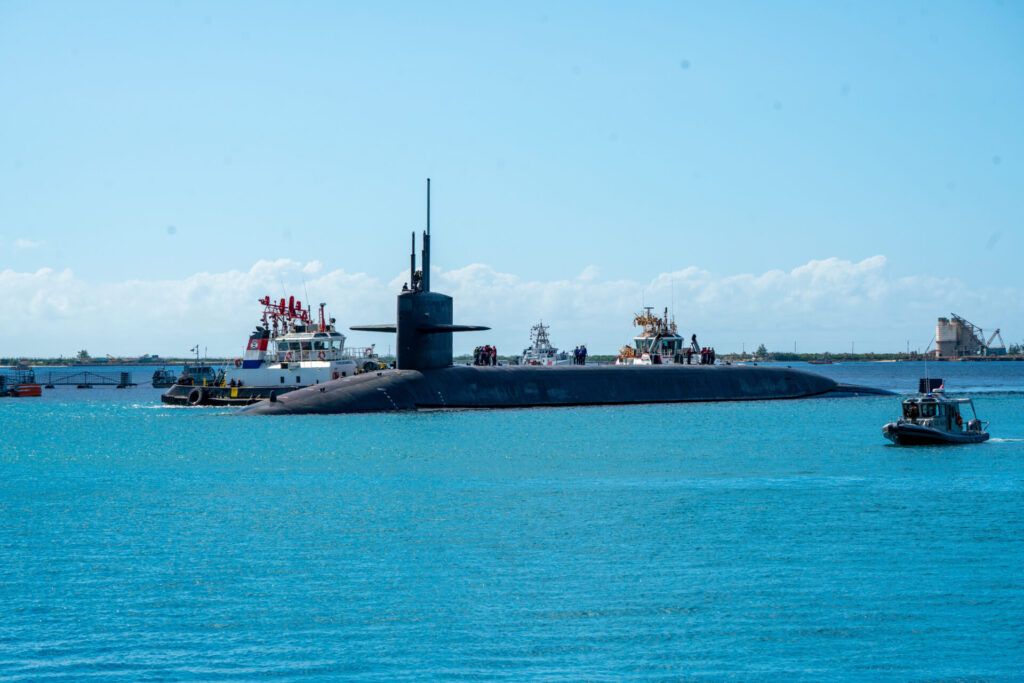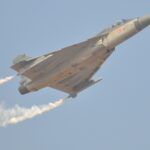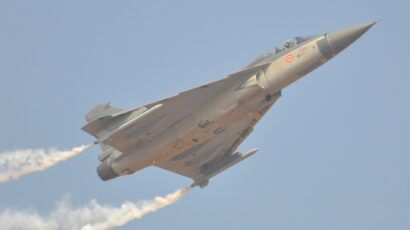Is America buying nuclear weapons to win a war or to prevent one?
By Jack O’Doherty | August 20, 2024
 The Ohio-class nuclear-armed ballistic missile submarine USS Louisiana arrives at Naval Base Guam on May 29, 2024, to conduct a scheduled port visit. Nuclear deterrence relies heavily on the survivability of such submarines.
The Ohio-class nuclear-armed ballistic missile submarine USS Louisiana arrives at Naval Base Guam on May 29, 2024, to conduct a scheduled port visit. Nuclear deterrence relies heavily on the survivability of such submarines.
We may have got it wrong. No, seriously. Analysts, scholars, and policy makers routinely grapple with opposing histories of nuclear strategy, but one perennial question is thought to have been resolved decades ago: What are nuclear weapons actually for?
Eyes roll and sighs are heard before somebody promptly insists that the usefulness of nuclear weapons was long ago codified as a means of ensuring strategic stability—predicated upon elegant theories of deterrence derived from a condition of supposed mutual vulnerability. A settled question then? Maybe not.
Imagine, for a moment, what a nuclear war would actually look like. Most people conjure up images of the sky ablaze like a vivid aurora, cities engulfed by thunderous firestorms, and entire nations glassed into oblivion. During the Cold War, such a cataclysm was not improbable, and even today it remains a possibility. But it is not the only possible outcome if deterrence fails.
Today, technological developments within the domains of hypersonics, anti-submarine warfare, missile defense, and AI-enabled data processing are, when considered cumulatively, changing the role of nuclear weapons within American defense strategy. These disruptive innovations are forcing scholars and strategists to reconsider longstanding and foundational assumptions about deterrence and risk. Old arguments have re-emerged, often energized and uncompromising, between perspectives that have internalized quite divergent Cold War lessons about how best to configure nuclear forces for strategic deterrence.
One school of thought stresses the importance of a secure second-strike capability, while the other focuses on the technical ability to preemptively launch a disarming first strike. American policy and targeting doctrine has, for the most part, historically relied on the ability to shoot first and take out an opponent’s nuclear weapons and other critical military assets.
The United States has begun a long overdue modernization of its nuclear arsenal, and it’s essential to understand the purpose of these acquisitions. The “why” and “how” of American nuclear weapons must be re-examined in consideration of emerging technologies that are complicating the logic underpinning nuclear strategy and policy. Are nuclear weapons being procured to win a war or to prevent one? Or both? Experts on both sides of a longstanding theoretical argument need to start talking to each other again.
Two schools of thought. The development of nuclear weapons started an inflexible and entangled debate between what—to borrow almost anachronistic language—may be described as the “nuclear revolution” and the “nuclear superiority” schools of thought. The former insists that mutual vulnerability (from which deterrence stability is derived) has revolutionized international competition by making wars between great powers essentially impossible. The latter, meanwhile, contends that the Pentagon should embrace nuclear warfighting postures revolving around a counterforce targeting doctrine—that is, shooting first in a preemptive strike to eliminate an opponent’s nuclear weapons before they can be launched (this is defined by its proponents as the only conceivable way to win a nuclear war).
These competing perspectives share the halls of power but rarely talk to each other. Each accuses the other of entertaining imaginary empirical pretensions, of a lazy misreading of history, and of celebrating theories compromised by their own basic premise. Indeed, jumping to conclusions without the requisite documentary or technical evidence is regarded as a pathology uniquely afflicting the other side.
The nuclear revolution school critiques counterforce strategies as being hopelessly untenable, invariably destabilizing, and a sure way to provoke an arms race. Meanwhile, the nuclear superiority school argues that the prevalence of the “revolution” thesis has consolidated the fragile conjecture that mutual vulnerability remains immune to technical innovation—that nuclear war remains an intangible abstraction. They warn that this shows an unwarranted confidence in deterrence—an inflexible trust in the existence and persistence of strategic stalemate.
In trying to extract Cold War lessons from the theorists of the past, both sides insist that the other has consulted the wrong material, made every known inferential error, and then internalized a conclusion where none credibly exists. Both positions seek stability and peace, but inflexibly claim that the other side’s convictions will precipitate catastrophe. Both sides think the other immoral. One tolerates a mutual hostage situation into perpetuity, while the other seeks to transcend that arrangement but would probably get us all killed in doing so. Surely, the other side must be lying or insane.
This debate matters because nuclear weapons policy really matters—and the emergence of disruptive military technologies has created new risks. It’s time for the American nuclear policy community to have a long-overdue conversation about what, prescriptively, US nuclear weapons are for. Deterrence, yes, but in what form?
Through declaratory policy and documents such as the Nuclear Posture Review, numerous continuities and ambiguities have been identified. Each of the two camps described above can read those official documents and conclude that its respective position is being validated. That said, both sides may agree that US nuclear targeting policy (insofar as it is publicly understood) is not based on “mutual vulnerability” with any other nation. This might reassure some (or most) in the superiority/counterforce school, but the revolution/stability school complains (as we have observed for decades) that government policy is blind to the strategic reality.
So, why does this debate matter today? Because disruptive technologies and a changing geostrategic environment are severely stressing stability and complicating traditional methods of mitigating nuclear risk. How the US defense community addresses these stressors will depend on an answer to the question of what American nuclear weapons seek to achieve—both in peace and war.
Disruptive anti-submarine technologies. By way of an example, consider an essential feature of American counterforce strategy—strategic anti-submarine warfare, which entails shadowing an adversary’s nuclear-armed ballistic missile submarines (SSBNs) and holding them at risk for prompt destruction should war occur. In any competition between nuclear powers, these SSBNs are the most survivable and therefore essential part of a nuclear triad that also includes weapons launched from the ground and from aircraft. Submarines are the foundation of strategic stability globally, and the integrity of deterrence relies almost entirely on their relative invulnerability.
America’s technological lead in anti-submarine warfare meant that, for much of the Cold War (and perhaps through to the present), US attack submarines shadowed Soviet (now Russian) SSBNs from port and throughout their deterrent patrols. The importance of this asymmetric advantage (that is, the ability to find and track an adversary’s nuclear submarines) cannot be overstated—it has traditionally been the most technically demanding challenge associated with prosecuting a disarming first strike.
Now, consider the emergence and maturation of unmanned surface vehicles like DARPA’s Sea Hunter and unmanned undersea vehicles like Boeing’s Orca. These long-endurance, uncrewed platforms—cheap enough to be procured in large numbers—can supplement the Navy’s existing fleet of Los Angeles, Seawolf, and Virginia-class attack submarines.
Additionally, analysts are cautiously studying an evolution in the sensor technology used to track submarines. Historically, passive acoustics (listening to sounds in the ocean using sonar on submarines and seabed-mounted hydrophone arrays) was the preferred detection method. However, passive acoustic detection increasingly cannot detect the quietest objects at tactically useful ranges, so it may be supplemented in coming years by low-frequency active sonar, which emits acoustic pulses and studies their reflections. As passive acoustic detection, and acoustic detection more broadly, becomes less capable of detecting exquisitely stealthy modern submarines, new sensing methods are attracting increased attention.
Experts are concerned that LIDAR, hydrodynamic pressure wave detection (or wake disturbance tracking), hyperspectral electro-optical and infrared imaging, and magnetic anomaly detection—augmented by AI-enhanced data processing and eventually quantum computing—might cumulatively and fatally undermine the survivability of nuclear ballistic missile submarines. These sensing technologies—redundant and distributed across numerous underwater, surface, and airborne assets—are making the oceans more transparent. The declining survivability of submarines is not a foregone conclusion, but the technological trends are readily apparent, and any such strategic shift will undoubtedly be felt asymmetrically.
Within American security circles, the nuclear superiority school welcomes a continued US advantage in undersea warfare and prescribes the ongoing trailing of Russian (and now Chinese) nuclear submarines—in the hope that, in wartime, those submarines can be promptly sunk, and with them a huge chunk of an enemy’s nuclear weapons neutralized. The nuclear revolution school, meanwhile, views this imbalance with dread and is deeply unsettled by the incentives it creates for a preemptive attack.
Regardless, there remains an enduring (if shaky) confidence in SSBN survivability, and all of the major nuclear powers are investing in a new generation of ballistic missile submarines.
These vessels are intended to be in service for many decades, and their acquisition by various nuclear powers with different nuclear postures suggests that ballistic missile submarines retain their indispensable role within deterrence. For now at least, they remain the best-suited platform for ensuring a retaliatory strike—and therefore support “mutual vulnerability”-based stability. However, these submarines are also exceptionally useful for preemptive strikes against an opponent’s land-based ballistic missile sites, so the acquisition of new submarines doesn’t really settle any debate.
Making sense of procurements. For American strategists, technological innovations within the realm of anti-submarine warfare may encourage reliance upon superiority-based strategies—especially considering the US Navy’s longstanding advantages in this arena. But this is merely a glimpse into an accelerating trend of disruptive innovation across numerous fields.
The emergence of hypersonic boost-glide vehicles has complicated nuclear strategy (though nobody can agree how), while a 2021 Chinese test reopened a decades-old debate about so-called fractional orbital bombardment systems in which nuclear weapons would be launched into space and then deorbited above their targets. Meanwhile, ballistic missile defense—famously divisive and responsible for countless arguments among defense experts—continues to evolve, with the US Navy’s SM-3 Block IIA interceptor conducting increasingly impressive tests. Regarding the difficult task of hunting land-based road-mobile nuclear missiles, there’s an ongoing and decidedly inconclusive debate about whether advances in synthetic aperture radar can solve this problem.
Disruptive technologies aren’t a new challenge for nuclear strategists. Indeed, Cold War arms racing featured successive revolutionary technologies that generated instability and prompted arms control measures. Today, the critical difference is the overwhelming number of concurrent disruptive technologies—which, when considered cumulatively, are stressing strategic stability in unprecedented and unpredictable ways. Strategists are struggling to precisely codify the roles and risks of these numerous advances across diverse technical fields.
These developments will have a direct impact on the efficacy of the American nuclear triad, which is currently undergoing a generational upgrade. Scholars from competing theoretical frameworks need to collaboratively interrogate the intended function and composition of the US arsenal.
The Sentinel intercontinental ballistic missile, Columbia-class SSBN, B-21 Raider stealth bomber, and Long-Range Stand-Off cruise missile each represent replacements of existing capabilities—and yet analysts can’t agree on whether these procurement programs indicate ambitious or cautious postures. In part, this is because such assessments are informed and swayed by pre-existing assumptions and preferences—for example, whether one subscribes to the nuclear revolution or nuclear superiority schools of thought, or neither.
The urgency here is simple: Disruptive technologies will favor one or the other school of thought. As a matter of policy, the United States can choose to invest in specific technologies conducive either to preserving mutual vulnerability or to pursuing war-winning counterforce options. This decision should determine which disruptive technologies are prioritized. If policy makers in Washington do not decide what the US nuclear arsenal is for, disruptive technology will essentially decide for them.
Together, we make the world safer.
The Bulletin elevates expert voices above the noise. But as an independent nonprofit organization, our operations depend on the support of readers like you. Help us continue to deliver quality journalism that holds leaders accountable. Your support of our work at any level is important. In return, we promise our coverage will be understandable, influential, vigilant, solution-oriented, and fair-minded. Together we can make a difference.
Keywords: anti-submarine, deterrence, nuclear revolution, nuclear superiority
Topics: Nuclear Weapons, Opinion, Voices of Tomorrow
















Could somebody, please, explain to me what WINNING a nuclear war means? Dare I ask whether winning means the absolute abolishment of nuclear weapons (an excellent thing, no doubt)? If all of them are used, there will be none left, and even less anybody to build them again for a very very long time. The goal of nuclear disarmament will be reached. To me, it sounds like a win. Finally, everlasting peace. The cockroaches shall inherit the Earth. To clarify: I am referring to the cute insects, not to our world great leaders. Even if some madmen are left in… Read more »
Russia had developed the K 329 Belgorod nuclear powered submarine able to carry 6 Poseidon nuclear torpedoes. The Poseidon is an intercontinental, nuclear powered, nuclear armed torpedo 24 meters in length and a diameter of 1.6 meters and run at about 150 mph so that it can’t be chased by any US submarine including the Ohio sub. See my article in Informed Comment on July 17. 2024
Fascinating and disturbing analysis. A much less advanced technology, the equipping by 2017 of W76 Trident warheads with superfuses which potentially enabled the destruction of all Russian missile silos, suggests US nuclear upgrades for some time have been aimed at winning a first strike. https://www.newscientist.com/article/mg23531440-500-the-new-nuclear-race-north-korea-isnt-the-biggest-problem/
Nuclear weapons are a “no win” entity. Millions of human beings will be sacrificed, no matter what nuclear strategies are adopted. That is unacceptable to everything every nation on earth strives to aspire to for the future of its citizens. The only answer, particularly now in this modern era of technology that is revealing to us the infinite mystery of our existence, is the protection and survival of Humanity as one singular priority on this planet Earth. We must always pursue non-nuclear answers to our inevitable global disagreements and conflicts. Nuclear energy is a gift that can bring great benefits… Read more »
Nice answer, I upvoted.
Great post, Terry Baker! Consider yourself upvoted, though, I don’t see my upvote in the tally. It says “0” right now. If anyone downvoted or purged my vote, then you ought to be ashamed of yourself. I have no more words for you.
Thank you for this well reasoned discussion. In a first-strike (pre-emptive) scenario we aim to destroy their attack capabilities before they irreparably damage us. The question is how much damage can we sustain to have a civilization that is recognizably still us? What would be the effect of losing 30 percent of our population, 60% of our productive agricultural land, and, probably, 90% of our industrial output? Could either side claim a recognizable sustainable victory? We cannot ignore the fact that our “opponents” also have many really clever people working on strategies and weapons systems that might ensure THEIR survival… Read more »